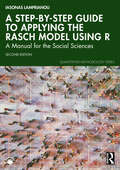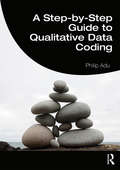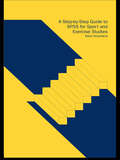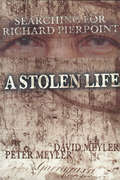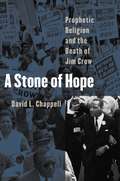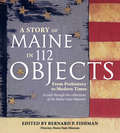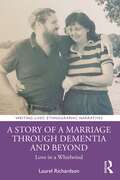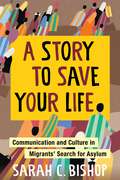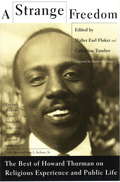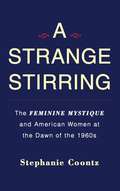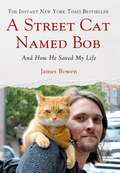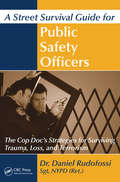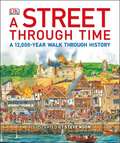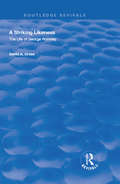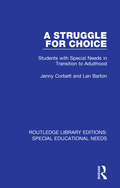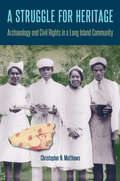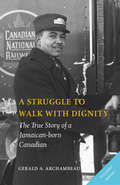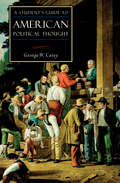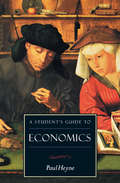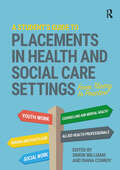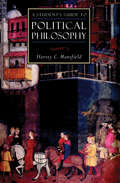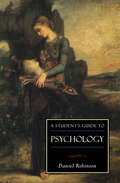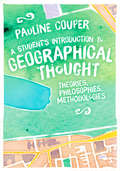- Table View
- List View
A Step-by-Step Guide to Applying the Rasch Model Using R: A Manual for the Social Sciences (Quantitative Methodology Series)
by Iasonas LamprianouThis new edition provides a step-by-step guide to applying the Rasch model in R, a probabilistic model used by researchers across the social sciences to measure unobservable (“latent”) variables. Although the focus is on simple R code, the book provides updated guidance through the point-and-click menus of BlueSky Statistics software.The book covers all Rasch models frequently used in social sciences, from the Simple Rasch model to the Rating Scale, Partial Credit, and Many-Facets Rasch models. Using a pragmatic approach to model-data fit, this book offers helpful practical examples to investigate Rasch model assumptions. In addition to traditional Rasch model approaches, it introduces the Rasch model as a special case of a Generalized Mixed Effects Model. Readers will also benefit from the online support material which includes all the code used in the book in downloadable and useable files.It also provides a comprehensive guide to R programming and practical guidance on using BlueSky Statistics software's point-and-click menus. This dual approach enables readers to experiment with data analysis using the provided data sets, enhancing their understanding and application of statistical concepts. It will be a valuable resource for both students and researchers who want to use Rasch models in their research.
A Step-by-Step Guide to Qualitative Data Coding
by Philip AduA Step-by-Step Guide to Qualitative Data Coding is a comprehensive qualitative data analysis guide. It is designed to help readers to systematically analyze qualitative data in a transparent and consistent manner, thus promoting the credibility of their findings. The book examines the art of coding data, categorizing codes, and synthesizing categories and themes. Using real data for demonstrations, it provides step-by-step instructions and illustrations for analyzing qualitative data. Some of the demonstrations include conducting manual coding using Microsoft Word and how to use qualitative data analysis software such as Dedoose, NVivo and QDA Miner Lite to analyze data. It also contains creative ways of presenting qualitative findings and provides practical examples. After reading this book, readers will be able to: Analyze qualitative data and present their findings Select an appropriate qualitative analysis tool Decide on the right qualitative coding and categorization strategies for their analysis Develop relationships among categories/themes Choose a suitable format for the presentation of the findings It is a great resource for qualitative research instructors and undergraduate and graduate students who want to gain skills in analyzing qualitative data or who plan to conduct a qualitative study. It is also useful for researchers and practitioners in the social and health sciences fields.
A Step-by-Step Guide to SPSS for Sport and Exercise Studies: A Step-by-Step Guide for Students
by Nikos NtoumanisSPSS is the international standard software package for data analysis in the social sciences. This book is the only SPSS guide designed specifically for students in the fields of sport, exercise and kinesiology. It Includes sport specific cases and data throughout.
A Stolen Life: Searching for Richard Pierpoint
by Peter Meyler David MeylerRichard Pierpoint or Captain Dick, as he was commonly known, emerges from the shadows of history in A Stolen Life: Searching for Richard Pierpoint. An African warrior who was captured at about age 16, Pierpoint lived his remaining years in exile. From his birth in Bundu (now part of Senegal) around 1744 until his death in rural Ontario in 1837, Pierpoint’s life allows us to glimpse the activity of an African involved in some of the world’s great events. "We are indebted to the authors for breathing life into this man, who though taken from his home early in his life still was able to make a significant contribution to the early history of Upper Canada. He fought, farmed and became a giant to the Black community. We thank you for a wonderful story of this often forgotten segment of Canadian history."— Wilma Morrison, Norval Johnson Heritage Library, Niagara Falls"Everybody knows about the Underground Railroad and the great many Black souls who emigrated to Canada via this route, but very few people know the brave Black men and women who put their lives on the line in defence of this country."— Ivor Christopher, Re-enactor, Runchey’s Company of Coloured Men"A well-researched and highly readable chronicle of Richard Pierpoint’s life in Africa and North America — as a slave, a soldier, and as a pioneer in Upper Canada’s wilderness. … a vitally important contribution to Canadian Black history."— Linda Brown-Kubisch, Author, Missouri
A Stone of Hope
by David L. ChappellThe civil rights movement was arguably the most successful social movement in American history. In a provocative new assessment of its success, David Chappell argues that the story of civil rights is not a story of the ultimate triumph of liberal ideas after decades of gradual progress. Rather, it is a story of the power of religious tradition.Chappell reconsiders the intellectual roots of civil rights reform, showing how northern liberals' faith in the power of human reason to overcome prejudice was at odds with the movement's goal of immediate change. Even when liberals sincerely wanted change, they recognized that they could not necessarily inspire others to unite and fight for it. But the prophetic tradition of the Old Testament--sometimes translated into secular language--drove African American activists to unprecedented solidarity and self-sacrifice. Martin Luther King Jr., Fannie Lou Hamer, James Lawson, Modjeska Simkins, and other black leaders believed, as the Hebrew prophets believed, that they had to stand apart from society and instigate dramatic changes to force an unwilling world to abandon its sinful ways. Their impassioned campaign to stamp out "the sin of segregation" brought the vitality of a religious revival to their cause. Meanwhile, segregationists found little support within their white southern religious denominations. Although segregationists outvoted and outgunned black integrationists, the segregationists lost, Chappell concludes, largely because they did not have a religious commitment to their cause.In a provocative assessment of the success of the civil rights movement, David Chappell reconsiders the intellectual roots of civil rights reform, showing how the prophetic tradition of the Old Testament--sometimes translated into secular language--drove African American activists to unprecedented solidarity and self-sacrifice. Martin Luther King Jr., Fannie Lou Hamer, James Lawson, Modjeska Simkins, and other black leaders believed, as the Hebrew prophets believed, that they had to stand apart from society and instigate dramatic changes to force an unwilling world to abandon its sinful ways. Although segregationists outvoted and outgunned black integrationists, the segregationists lost, Chappell concludes, largely because they did not have a religious commitment to their cause.-->
A Story of Maine in 112 Objects: From Prehistory To Modern Times
by Bernard P. FishmanPUBLISHED WITH THE MAINE STATE MUSEUM Founded in 1836, the Maine State Museum is America’s oldest state museum and is known to many as “Maine’s Smithsonian” because of the breadth and diversity of its holdings—nearly a million objects covering every aspect of the state’s cultural, biological, and geological history—and the thousands of stories its collections tell. For this book the museum selected and photographed 112 artifacts and specimens that, together, tell an epic story of the land and its people from prehistoric times to the present. It is a story covering 395 million years, a story told with a walrus skull and fossils, tourmaline and spear points, mammoth tusks and bone fishhooks, Norse coins and caulking irons, militia flags and survey stakes, treaty documents and wooden tankards, a temperance banner and a locomotive, Joshua Chamberlain’s pistol and a cod tub trawl, a Lombard log hauler and a woman’s WWII welding outfit, L. L. Bean boots and German POW snowshoes, and many more objects from the museum’s collections. Short narratives written by museum curators are woven around each item—including photos of related objects—and the ensemble has been honed, polished, and introduced by museum director Bernard Fishman. This is a book that historians and Maine residents and visitors will delve into again and again, unearthing new treasures with each reading.
A Story of a Marriage Through Dementia and Beyond: Love in a Whirlwind (Writing Lives: Ethnographic Narratives)
by Laurel RichardsonA Story of a Marriage Through Dementia and Beyond is the extraordinary, unflinching account from sociologist Laurel Richardson of her love and caregiving through the last period of her husband Ernest Lockridge's life - from his transient amnesia to his death from Lewy Body Dementia. Focusing on the lived experience of the caregiver through the loved one’s journey from mild cognitive impairment to death, the book gives the reader the experience of what the medical diagnoses mean and what has led up to the loss. It shows the complex, nuanced lives of a couple both living with the worst effects of a disease like Lewy Body Dementia, while maintaining, sometimes with hope and laughter, their loving connection nourished through a 40-year marriage. Dementia is a ‘silver tsunami’ - the third leading cause of death amongst senior populations. Richardson’s beautifully written book gives on-the-ground emotional support to those already in service as caregivers and helps prepare others for such service. Hospices, book clubs, and medical and allied professionals will find this book extraordinarily valuable. Weaving in autoethnographic and sociological methods and scholarship, as well as a list of reading and further resources for caregivers and scholars, this book will also appeal to courses in a wide range of disciplines and fields, including health communication, nursing and allied health, courses covering death and dying, end-of-life, and illness care, and, of course, scholars pursuing autoethnography, creative non-fiction, and qualitative methods.
A Story to Save Your Life: Communication and Culture in Migrants' Search for Asylum
by Sarah BishopA young woman flees violence in Mexico and seeks protection in the United States—only to be trafficked as a domestic worker in the Bronx. A decorated immigration judge leaves his post when the policies he proudly upheld capsize in the wake of political turmoil. A Gambian translator who was granted asylum herself talks with other African women about how immigration officers expect victims of torture to behave. A border patrol officer begins to question the training that instructs him to treat the children he finds in the Arizona desert like criminals.Through these and other powerful firsthand accounts, A Story to Save Your Life offers new insight into the harrowing realities of seeking protection in the United States. Sarah C. Bishop argues that cultural differences in communication shape every stage of the asylum process, playing a major but unexamined role. Migrants fleeing persecution must reconstruct the details of their lives so governmental authorities can determine whether their experiences justify protection. However, Bishop shows, many factors influence whether an applicant is perceived as credible, from the effects of trauma on the ability to recount an experience chronologically to culturally rooted nonverbal behaviors and displays of emotion. For asylum seekers, harnessing the power of autobiographical storytelling can mean the difference between life and death. A Story to Save Your Life emphasizes how memory, communication, and culture intertwine in migrants’ search for safety.
A Strange Freedom
by Howard ThurmanA spiritual advisor to Martin Luther King, Jr.; the first black dean at a white university; cofounder of the first interracially pastored, intercultural church in the United States, Howard Thurman offered a transcendent vision of our world. This lyrical collection of select published and unpublished works traces his struggle with the particular manifestations of violence and hatred that mark the twentieth century. His words remind us all that out of religious faith emerges social responsibility and the power to transform lives.
A Strange Stirring: The Feminine Mystique and American Women at the Dawn of the 1960s
by Stephanie CoontzIn 1963, Betty Friedan unleashed a storm of controversy with her bestselling book, The Feminine Mystique. Hundreds of women wrote to her to say that the book had transformed, even saved, their lives. Nearly half a century later, many women still recall where they were when they first read it. In A Strange Stirring, historian Stephanie Coontz examines the dawn of the 1960s, when the sexual revolution had barely begun, newspapers advertised for "perky, attractive gal typists," but married women were told to stay home, and husbands controlled almost every aspect of family life. Based on exhaustive research and interviews, and challenging both conservative and liberal myths about Friedan, A Strange Stirring brilliantly illuminates how a generation of women came to realize that their dissatisfaction with domestic life didn't reflect their personal weakness but rather a social and political injustice.
A Street Cat Named Bob: And How He Saved My Life
by James BowenThe Instant New York Times Bestseller! James is a street musician struggling to make ends meet. Bob is a stray cat looking for somewhere warm to sleep. When James and Bob meet, they forge a never-to-be-forgotten friendship that has been charming readers from Thailand to Turkey. A Street Cat Named Bob is an international sensation, landing on the bestseller list in England for 52 consecutive weeks and selling in 26 countries around the world. Now, James and Bob are ready to share their true story with the U. S. in this tale unlike any you’ve ever read of a cat who possesses some kind of magic. When street musician James Bowen found an injured cat curled up in the hallway of his apartment building, he had no idea how much his life was about to change. James was living hand to mouth on the streets of London, barely making enough money to feed himself, and the last thing he needed was a pet. Yet James couldn't resist helping the strikingly intelligent but very sick animal, whom he named Bob. He slowly nursed Bob back to health and then sent the cat on his way, imagining that he would never see him again. But Bob had other ideas. Perfect for fans of Marley & Me: Life and Love with the World's Worst Dog and Dewey: The Small-Town Library Cat That Changed the World, this instant classic about the power of love between man and animal has taken the world by storm and is guaranteed to be a huge hit with American fans as well. Note: Does not use standard American spelling or punctuation.
A Street In Marrakech: A Personal View of Urban Women in Morocco
by Elizabeth Warnock FerneaThis is a reflexive account of an American woman and her family's unpredictable journey through the private and public worlds of a traditional Muslim city in the process of change. As a Western stranger in Marrakech, Fernea was met with suspicion and hostility. The story of the slow growth of trust and acceptance between the author and her Moroccan neighbors involves the reader in everyday activities, weddings, funerals, and women's rituals. Both the author and her friends are changed by the encounters that she describes. This is a crosscultural adventure, ethnographically sound, and written in an accessible style.
A Street Survival Guide for Public Safety Officers: The Cop Doc's Strategies for Surviving Trauma, Loss, and Terrorism
by Daniel RudofossiAn expansion of Dr. Rudofossi's theory of Police and Public Safety Complex Trauma, this text integrates other models of trauma and loss into a one-of-a-kind intervention model. It offers insider perspectives from police psychologists, police managers, and clinicians describing what police personnel experience on the job, along with expert intervent
A Street Through Time
by Dorling KindersleyThis book views a street by the river through the ages and how it has evolved.
A Street Through Time: A 12,000 Year Journey Along the Same Street (DK Panorama)
by DKHave you ever wondered what your street was like thousands of years ago? This illustrated history book for children takes you on a 12,000-year journey to find out the story of a single street.Think of the street you live on. Now think of how it may have looked in the Stone Age in 10,000 BCE, or in Victorian times during the Industrial Revolution, or how it may look 50 years from now. A Street Through Time takes you on a time-traveling journey that you won't forget. Highly detailed illustrations bring 15 key periods in time to life. You will see magnificent buildings go up and come down, new churches built on the site of ancient temples, wooden bridges destroyed and then remade in stone, and statues demolished then unearthed many years later. You'll find out how people lived long ago - the tools they used, what they wore, and what they did all day. Revised and updated for a new generation, A Street Through Time now includes a look at the street 50 years in the future.
A Striking Likeness: The Life of George Romney
by David A CrossThis title was first published in 2000: In their stunning simplicity, George Romney's portraits of eighteenth-century gentry and their children are among the most widely recognised creations of his age. A rival to Reynolds and Gainsborough, Romney was born in 1734 on the edge of the Lake District, the landscape of which never ceased to influence his eye for composition and colour. He moved in 1762 to London where there was an insatiable market for portraits of the landed gentry to fill the elegant picture galleries of their country houses. Romney's sitters included William Beckford and Emma Hart, later Lady Hamilton. An influential figure, one of the founding fathers of neo-classicism and a harbinger of romanticism, Romney yearned to develop his talents as a history painter. Countless drawings bear witness to ambitious projects on elemental themes which were rarely executed on canvas. Richly illustrated, this is the first biography of Romney to explore the full diversity of his oeuvre.
A Struggle for Choice: Students with Special Needs in Transition to Adulthood (Routledge Library Editions: Special Educational Needs #8)
by Jenny Corbett Len BartonFirst published in 1992. For disabled people and people with learning difficulties the transition from school to college, work or training can be stressful and frustrating; job choices are often restricted, and they face barriers which are beyond their control. This book is about their struggle for choice. It sets special needs in further education in a socio-political context. By exploring the concept of ‘transition to adulthood’ in terms of class, race, gender and disability differences, and relating it to social, economic and political influences, it seeks to challenge complacency and encourage dialogue and debate.
A Struggle for Heritage: Archaeology and Civil Rights in a Long Island Community (Cultural Heritage Studies)
by Christopher N. MatthewsBased on ten years of collaborative, community-based research, this book examines race and racism in a mixed-heritage Native American and African American community on Long Island’s north shore. Through excavations of the Silas Tobias and Jacob and Hannah Hart houses in the village of Setauket, Christopher Matthews explores how the families who lived here struggled to survive and preserve their culture despite consistent efforts to marginalize and displace them over the course of more than 200 years. He discusses these forgotten people and the artifacts of their daily lives within the larger context of race, labor, and industrialization from the early nineteenth to the mid-twentieth century. A Struggle for Heritage draws on extensive archaeological, archival, and oral historical research and sets a remarkable standard for projects that engage a descendant community left out of the dominant narrative. Matthews demonstrates how archaeology can be an activist voice for a vulnerable population’s civil rights as he brings attention to the continuous, gradual, and effective economic assault on people of color living in a traditional neighborhood amid gentrification. Providing examples of multiple approaches to documenting hidden histories and silenced pasts, this study is a model for public and professional efforts to include and support the preservation of historic communities of color. A volume in the series Cultural Heritage Studies, edited by Paul A. ShackelPublication of the paperback edition made possible by a Sustaining the Humanities through the American Rescue Plan grant from the National Endowment for the Humanities.
A Struggle to Walk With Dignity: The True Story of a Jamaican-born Canadian
by Gerald A. ArchambeauGerald Augustus Archambeau was born in Jamaica in 1933. Raised in Kingston by his three aunts, he was sent to Canada in 1947 to join his mother and stepfather in Montreal. He trained in the plumbing and steam-fitting trade, but at age eighteen decided to join the railway as a passenger car porter. He worked for Canadian Pacific and Canadian National until the 1960s, when declining passenger rail traffic and the ascendence of air travel caused him to switch to a career with a major Canadian airline in Toronto. After his retirement from the airline, Gerald and his wife, Marion, settled in St. Catharines, Ontario.
A Student's Guide to American Political Thought (ISI Guides to the Major Disciplines)
by George W. CareyA concise overview of the competing political philosophies that have shaped United States history. Who are the most influential thinkers, and which are the most important concepts, events, and documents in the study of the American political tradition? How ought we regard the beliefs and motivations of the founders, the debate over the ratification of the Constitution, the historical circumstances of the Declaration of Independence, the rise of the modern presidency, and the advent of judicial supremacy? These are a few of the fascinating questions canvassed by George W. Carey in A Student&’s Guide to American Political Thought. Carey&’s primer instructs students on the fundamental matters of American political theory while telling them where to turn to obtain a better grasp on the ideas that have shaped the American political heritage.
A Student's Guide to Economics (ISI Guides to the Major Disciplines)
by Paul HeyneWhat makes economies work—or not work? This concise overview of the field&’s great thinkers offers a wealth of information. Paul Heyne, one of the nation&’s best-selling economists, provides an accessible overview of the discipline of economics. Economic knowledge, he contends, is not complete without reference to the totality of human society—a realization essential to a proper understanding of the fundamental principles of economics. The sweep of economic thinking is presented here with reference to the great economists and important schools of thought.
A Student's Guide to Placements in Health and Social Care Settings: From Theory to Practice
by Simon Williams Diana ConroySupporting students on placements in health and social care settings, this accessible guide provides a framework for understanding the theory behind successful practice as well as the critical skills needed to apply it. A Student's Guide to Placements in Health and Social Care Settings takes theory beyond the classroom and apply it to real settings, enabling students to recognise their own learning journey and develop their own distinct professional identity within a wider interprofessional context.This is a key resource for placement experience with insights from experts and advice direct from students who have already been on placement. With clear guidelines, and structured so that you can dip into different chapters as needed, it responds to the unique nature of placement opportunities and is the first line resource students should turn to.Whatever course you’re studying in the caring profession - Social Work, Health and Social Care, Youth Work, Nursing or Counselling – this is essential reading to help understand how theory can support and improve your placement experience, ensuring you get the very most out of it.
A Student's Guide to Political Philosophy (ISI Guides to the Major Disciplines)
by Harvey C. MansfieldA primer on the bedrock principles of politics from &“Harvard&’s most controversial conservative professor&” and the author of Democracy in America (Boston magazine). Behind the daily headlines on presidential races and local elections is the theory of the polity—or what the end of our politics should be. Harvard&’s Harvey C. Mansfield, one of America&’s leading political theorists, explains why our quest for the good life must address the type of government we seek to uphold. He directs our gaze to the thinkers and philosophies and classic works that have proved most influential throughout the ages.
A Student's Guide to Psychology (ISI Guides to the Major Disciplines)
by Daniel RobinsonPsychology is frequently the most popular major on campus, but it can also be the most treacherous. In this guide, Daniel N. Robinson surveys the philosophical and historical roots of modern psychology and sketches the major schools and thinkers of the discipline. He also identifies those false prejudices--such as contempt for metaphysics and the notion that the mind can be reduced to the chemical processes of the brain--that so often perplex and mislead students of psychology. He ends by calling for psychology to investigate more intensively the problems of moral and civic development. Readers will find Robinson's book to be an indispensable orientation to this culturally influential field.
A Student's Introduction to Geographical Thought: Theories, Philosophies, Methodologies
by Pauline CouperThis ism-busting text is an enormously accessible account of the key philosophical and theoretical ideas that have informed geographical research. It makes abstract ideas explicit and clearly connects it with real practices of geographical research and knowledge. Written with flair and passion, A Student's Introduction to Geographical Thought: Explains the key ideas: scientific realism, anti-realism and idealism / positivism / critical rationalism / Marxism and critical realism/ social constructionism and feminism / phenomenology and post-phenomenology / postmodernism and post-structuralism / complexity / moral philosophy. Uses examples that address both physical geography and human geography. Use a familiar and real-world example - ‘the beach’ - as an entry point to basic questions of philosophy, returning to this to illustrate and to explain the links between philosophy, theory, and methodology. All chapters end with summaries and sources of further reading, a glossary explaining key terms, exercises with commentaries, and web resources of key articles from the journals Progress in Human Geography and Progress in Physical Geography. A Student's Introduction to Geographical Thought is a completely accessible student A-Z of theory and practice for both human and physical geography.
